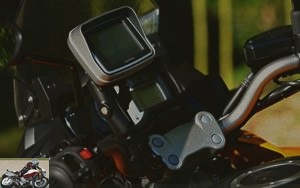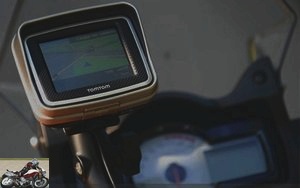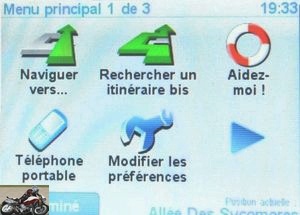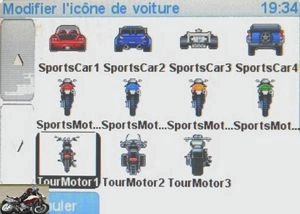Menus
Motorcycle GPS, 2nd edition
 The TomTom Rider – now in its version II – is the GPS specially designed for motorcycles by TomTom. Available in France and Europe version, it has not aesthetically changed since its launch … It is a huge box with – compared to the latest GPS – a rather small screen. It is especially one of the most expensive GPS at 599.95 € TTC (in its European version, 499 euros for the France version) even if it is found a little cheaper on the Internet. Its version I was known for its fragile support, poorly resistant to vibrations and motorcycle stresses. So, does the product live up to its price and is the investment worth it? Test…
The TomTom Rider – now in its version II – is the GPS specially designed for motorcycles by TomTom. Available in France and Europe version, it has not aesthetically changed since its launch … It is a huge box with – compared to the latest GPS – a rather small screen. It is especially one of the most expensive GPS at 599.95 € TTC (in its European version, 499 euros for the France version) even if it is found a little cheaper on the Internet. Its version I was known for its fragile support, poorly resistant to vibrations and motorcycle stresses. So, does the product live up to its price and is the investment worth it? Test…
Discovery
The TomTom Rider is huge, especially in thickness, with a thickness two to three times greater than the usual GPS (for car). Despite its imposing size (113.2mm x 96.2mm x 52.9mm), its screen is nothing extraordinary in terms of size with its only 3.5 inches (8.9 cm) compared to 4.3 screens. inches (11 cm) or even more, since some GPS devices now offer 7-inch screens, which is double the size. On the other hand, with 310 grams, it remains in the standard weights.
The Rider comes with a Cardo Scala Rider helmet, which allows you to hear the indications via the Bluetooth connection.
It also comes with a bracket to install it on the motorcycle.

Then add the "accessories" such as the SD memory card with cartography, charger, some cables, a cover for the TomTom, a strap to connect the TomTom to the motorcycle and paper documentation (very basic). Integrated help is provided much more.
Note that you can download – free of charge – the update of the integrated map up to one month after purchase.
Installation
The Ram Mounts support consists mainly of three parts: a block to be fixed around the handlebars (a caliper with two 11 nuts), a central articulation with 2 ball joints and the GPS support. The quality and the finish are there. And the whole thing is very solid.
All of this is very easy to install in just a few minutes. It can be uninstalled just as easily…. with the risk of the support being pricked. And at more than 33 euros the support, its regular renewal rather encourages to dismantle it regularly.

Contact
The TomTom Rider is turned on via a button on the right of the device. It must be kept pressed for several seconds before it turns on; it is not likely to ignite on its own, that is undeniable. It is switched off using the same button, but more easily.
What is surprising about the ignition is above all the speed of ignition and the location of the satellites. It’s almost instantaneous, even while riding. When you compare to other TomTom car models which sometimes take more than 20 seconds to acquire and update the map, this is a real plus. It even happens to pick up inside a house…. what other GPS never can. Thanks to the SiRF Star III GPS chipset.
The screen is easy to read during the day, and even more so at night, and it only admits its limits with a strong sun … which is why the case has a cap that mitigates the phenomenon a little..

The screen being touch-sensitive, everything is easily done by pressing the screen, even with gloves, or even some winter gloves. Those used to TomTom models will not be at a loss…. navigation is almost identical with the other models. There is even the icon "change the car icon" …. but you can choose a motorcycle model from the list !

Test
The advantage of the supplied stand is that it raises the position of the GPS and really helps you find the best reading orientation for the case. Suddenly, you can read the GPS without taking your eyes off the road. The support is so well made and adjustable that it is easily adaptable to all motorcycles, trails, roadsters, sports and always offers the best possible vision.
On the usage side, the GPS is easily turned on and off with a long press, which saves the battery … which otherwise does not last more than 3 hours, maximum. And this is really the weak point of GPS, especially for mobile use. Not all motorcycles have a cigarette lighter. It is therefore necessary to manage to mount a power supply by going to prick the battery. The cabling is provided and the support is used to bring electricity.
The route calculations are very fast. And when you miss an exit, or a street, he recalculated a route in less than two seconds…. and if the next street is the right one, then we have time to take it. And the overall guidance is good.
That said, the maps must be updated regularly…. otherwise, we can seemingly find ourselves in the open field; what happened to me recently taking the N4 and arriving in Nancy. Clearly, there was no official road where I was passing. On the other hand, it can happen to him to pass by dirt roads to go faster from one point to another in the provinces.
For radars, the subject is a little identical. Their position is not always reliable. Do not hesitate to install the Maxi-Box software and go get free databases on the TomTomMax site.
Recharge
The Rider discharges quickly…. taking between 2 and 3 hours maximum, insufficient to guide a whole day of ride and roadbook. As for recharging, there is no illuminated exterior charge indicator, so it should not be forgotten. On the other hand, the screen charge indicator when it is on quickly alerts by flashing red !
Conclusion
To try it is to adopt it ? Having a real motorcycle GPS with a quality support has nothing to do with a car GPS housed in a plastic cover which significantly reduces visibility in all weather conditions. Another advantage is that the GPS is placed higher here and does not require you to take your eyes off the road. And it remains visible even with a tank bag. The support has proven to be strong and resistant despite many mounts and disassemblies on several motorcycles and operation in a thunderstorm. The Tom Tom Rider is finally intuitive in terms of use. Only its high price can deter the purchase. We are already talking about a V3 version in the meantime…
Strong points
- Sealing
- Speed of satellite connection
- Support
Weak points
- Price
- Autonomy
- POI (speed camera positions, etc …) to be updated regularly
Related articles
-
Portrait and rotating landscape mode, winding and uneven roads, speed camera warning, roadbook sharing The ultimate evolution of the special biker…
-
Honda CMX 500 Rebel S motorcycle test
Little rebellious bobber In-line twin, 471 cm3, 45 hp at 8,500 rpm, 44.6 Nm at 6,000 rpm, 190 kilos, € 6,299 Rather bi or 4? It’s that the couple is…
-
Comparative motorcycle test Kawasaki Ninja 650 A2 and full
Daily trial for 15 days of both versions 649 cc, 68 hp – 47.5 hp in A2 – for 193 kilos Who remembers the ER-6, the model unveiled in 2005 and since…
-
Bavarian sauce cruiser with a real engine and pieces of history in it Big Boxer of 1,802 cm3, 3 driving modes, 91 hp, 158 Nm, 345 kg, from 22,990 euros…
-
Benelli Imperiale 400 motorcycle test
EVO Classic 374 cc single cylinder, 21.1 hp, 29 Nm, 205 kg, 4,399 euros Benelli is the oldest existing brand in Italy. But we should no longer say…
-
Daily test over 3,500 kilometers, from Spain to Italy by small roads Flat Twin of 1,254 cm3, euro5, 136 hp and 143 Nm, 279 kg, 22,490 euros … and the…
-
2007 Kawasaki Z1000 motorcycle test
Five-day test of the 2007 vintage roadster The Kawasaki Z1000 released in 2003 was well received but mixed: a look of hell but an engine considered like…
-
Kawasaki Versys 650 motorcycle test
Twin-cylinder 649 cc, 69 hp, 210 kilos, A2 version, euro5 ready Daily test 2006, the year of the successive revivals of Kawasaki on segments where we…
-
Ducati Multistrada V4 S motorcycle test
La dolce-veloce vita V4 Granturismo of 1.158 cm3, 170 hp and 125 Nm, 243 kg, radars, semi-active suspensions, from 19.590 €… It’s been almost twenty…
-
Honda CBR 600 RR motorcycle test
1700 km test The CBR 600 RR is the Honda hypersport, the ultimate weapon of the Hamamatsu firm, whose lineage with the RC211V is evident. The 2010…